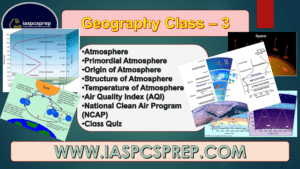| Geography Class-3 Atmosphere PDF |
[pdf-embedder url=”https://www.iaspcsprep.com/wp-content/uploads/2024/03/Geography-Class-3.pdf” title=”Geography (Class-3)”]
The link of PDF of this Geography Class-3 Atmosphere is given below the explanation of the class, you can download the PDF by going below.
Geography Class-3 Atmosphere
In this Geography Class-3 Atmosphere, we will discuss about the Atmosphere, Primordial Atmosphere, Origin of Atmosphere, Structure of Atmosphere, AQI, NCAP etc.
Topics to be covered in this Article :-
- Atmosphere
- Primordial Atmosphere
- Origin of Atmosphere
- Structure of Atmosphere
- Temperature of Atmosphere
- Air Quality Index (AQI)
- National Clean Air Program (NCAP)
Atmosphere
The atmosphere is a layer of gases that surrounds a planet, like Earth. It’s held in place by gravity and extends outward from the planet’s surface. The atmosphere is essential for life on Earth as it provides the air we breathe, shields us from harmful radiation from the sun, and regulates the planet’s temperature. It’s composed of various gases, primarily nitrogen (about 78%) and oxygen (about 21%), with traces of other gases such as carbon dioxide, argon, and water vapor. The atmosphere is divided into several layers based on temperature and composition, each with its own unique characteristics and functions.
Important Points:-
- The envelope of gases surrounding the Earth is called the atmosphere.
- It plays a crucial role in sustaining life on Earth.
- It’s made up of different gases, like oxygen, nitrogen, carbon dioxide, and others.
- It protects us from the Sun’s harmful rays and regulates temperature.
Primordial Atmosphere
The primordial atmosphere refers to the very early atmosphere of the Earth. It was formed billions of years ago when the Earth was still in its infancy. This atmosphere was mostly made up of gases like hydrogen and helium.
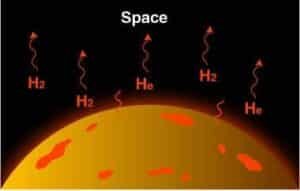
- Originated around 4.6 billion years ago during Earth’s formation.
- Mostly composed of hydrogen and helium gases.
Origin of Atmosphere
- Primordial atmosphere formed from gases released during Earth’s formation.
- Secondary atmosphere developed from volcanic outgassing, releasing gases like carbon dioxide and water vapor.
The atmosphere of the Earth was formed over billions of years through various processes such as volcanic activity, outgassing from the Earth’s interior, and the impact of comets and asteroids. These processes released gases like nitrogen, oxygen, carbon dioxide, and water vapor into the atmosphere.
Structure of Atmosphere
The Earth’s atmosphere is a complex and layered system composed of several distinct layers, each with its own unique characteristics. These layers are defined primarily by changes in temperature with altitude, as well as by the composition of gases within them. From the surface of the Earth upwards, the atmosphere is generally divided into five main layers: the troposphere, stratosphere, mesosphere, thermosphere, and exosphere. Each layer has distinct characteristics and properties.
1. Troposphere:
- Altitude Range: Surface of the Earth up to 8 km at the poles and up to 18 km at the Equator.
- Temperature Profile: Temperature decreases with increasing altitude.
- Key Features:
- Most weather phenomena occur here, earning it the title of the “weather-making layer.”
- Upper limit is called the tropopause.
- Contains about 75-80% of the atmosphere’s mass.
- The boundary between the troposphere and the layer above it, known as the stratosphere, is called the tropopause. Above the tropopause, temperature remains relatively constant or may even increase with altitude due to the presence of the ozone layer, which absorbs ultraviolet radiation from the sun.
2. Stratosphere:
- Altitude Range: Extends from the tropopause to about 50 km above the Earth’s surface.
- Temperature Profile: Temperature increases with increasing altitude, due to ozone absorption of solar ultraviolet radiation.
- Key Features:
- Often referred to as the ozonosphere due to the concentration of ozone molecules.
- Commercial jet planes typically fly in this layer.
- Upper limit is called the stratopause.
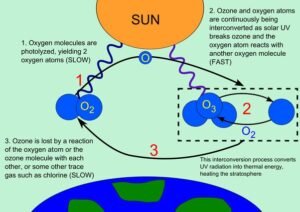
3. Mesosphere:
- Altitude Range: Extends between 50 km and 80 km above the Earth’s surface.
- Temperature Profile: Temperature decreases with increasing altitude, reaching lows of around -90°C.
- Key Features:
- Radio waves transmitted from Earth are reflected back from this layer.
- Most meteors nearing Earth’s horizon burn up in this layer.
- Uppermost limit is called the mesopause.
4. Thermosphere:
- Altitude Range: Extends from the mesopause up to about 500 km above the Earth’s surface.
- Temperature Profile: Temperature increases significantly with increasing altitude.
- Key Features:
- Contains the ionosphere, where ionization of gases occurs due to solar radiation.
- Satellite orbits and auroras occur in this layer.
- Despite the high temperatures, the density of the thermosphere is very low.
5. Ionosphere:
- Altitude Range: The ionosphere extends from about 60 kilometers above the Earth’s surface to roughly 1,000 kilometers and is a region where the Earth’s atmosphere merges with space.
- Temperature Profile: Within the ionosphere, there is no distinct temperature profile as seen in other layers of the atmosphere. Temperatures can vary widely depending on factors such as solar activity and altitude within the ionosphere.
- Key Features:
- This region overlaps with the upper mesosphere, thermosphere, and exosphere.
- The ionosphere is divided into several layers, including the D layer, E layer, F layer, and sometimes the G layer. These layers vary in altitude and ionization density depending on factors such as solar activity, time of day, and geographic location.
- (i) First layer (i.e. low layer) is called as D-layer. D-layer reflects low frequency radio waves and dissociates after sunset.
(ii) Second layer is called as E-layer (also called as Kennelly and Heaviside layer). E-layer reflects medium frequency radio waves and also dissociates after sunset.
(iii) Next layer is F-layer (also called as Appleton layer). F-layer reflects high frequency radio waves and partially dissociates after sunset.
(iv) Above this, there is G-layer also. G-layer doesn’t dissociates after sunset and doesn’t play important role in radio waves. - The ionosphere plays a crucial role in radio communications and navigation. It reflects and refracts radio waves, allowing long-distance communication beyond the line of sight. This property of the ionosphere is utilized in technologies such as shortwave radio communication, over-the-horizon radar, and global navigation satellite systems (GNSS) like GPS.
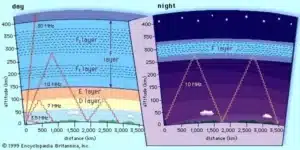
6. Exosphere:
- Altitude Range: The outermost layer of Earth’s atmosphere. Begins around 500 km above the Earth’s surface and extends indefinitely into space.
- Temperature Profile: No distinct temperature profile; temperatures can vary widely.
- Key Features:
- Transition zone between Earth’s atmosphere and outer space.
- Gas molecules in this layer are so sparse that they can travel long distances without colliding with each other.
- Satellites orbit within this layer.
Overall, the structure of the Earth’s atmosphere plays a crucial role in regulating the planet’s climate, weather patterns, and the distribution of life. Each layer has its own unique characteristics and importance in maintaining the delicate balance that supports life on Earth.
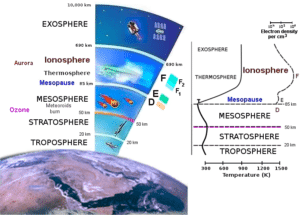
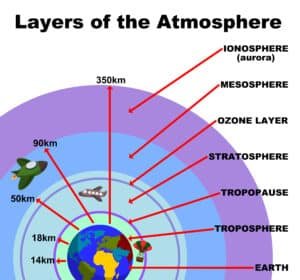
Temperature of Atmosphere
The temperature of the Earth’s atmosphere varies with altitude and location. In general, the atmosphere’s temperature decreases with increasing altitude in the troposphere, remains relatively stable in the stratosphere, increases in the mesosphere, and can reach extremely high temperatures in the thermosphere.
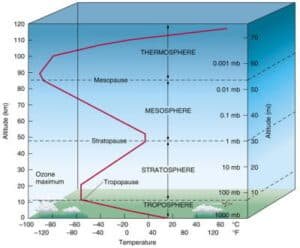
Present State (CO2)
Carbon dioxide (CO2) concentration in the atmosphere has been increasing due to human activities, primarily burning fossil fuels and deforestation. Too much of it can make Earth warmer.
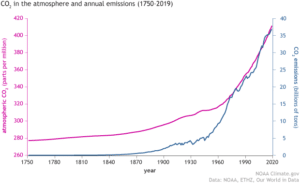
The amount of carbon-dioxide in the atmosphere has increased along with human emissions since the start of the Industrial Revolution in 1750. CO2 emissions rose slowly to about 5 billion tons a year in the mid-20th century before skyrocketing to more than 35 billion tons per year by the end of the century.
Present State [Global Atmospheric Methane {ppb}]
Methane (CH4) concentration in the atmosphere has also been rising due to agricultural activities, landfills, and fossil fuel production. Too much methane can also make Earth warmer.
- Methane is another greenhouse gas, albeit less abundant than CO2.
- Its levels have also been rising due to human activities like agriculture and fossil fuel extraction.
- Methane contributes to global warming too.
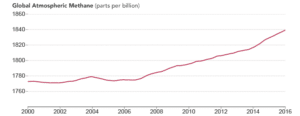
- The concentration of Methane has increased significantly in 21st century from 1775 ppb (2000) to 1840 ppb presently.
- Contribution : 50% of the pollution or carbon-dioxide has comes from Industries, 27% from Vehicles, 17% from crop residues and 7% by domestic cooking etc.
Air Quality Index (AQI)
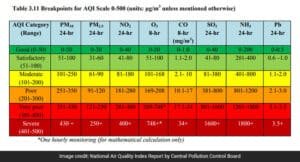
- AQI is a measure of how clean or polluted the air is.
- It takes into account pollutants like ozone, particulate matter, carbon monoxide, sulfur dioxide, and nitrogen dioxide.
- Different levels of AQI indicate different health risks.
- It is an index includes 8 major pollutants. A cumulative index is calculated to represent air quality for which a colour is assigned.
-
-
- PM10 (Particulate Matter → 10)
- PM2.5 (Particulate Matter → 2.5)
- NO2 (Nitrous Oxide)
- O3 (Ozone)
- CO (Carbon Monoxide)
- SO2 (Sulphur Dioxide)
- NH3 (Ammonia)
- Pb (lead)
-
National Clean Air Programme (NCAP)
- NCAP is a government initiative to tackle air pollution in India.
- It aims to reduce air pollution levels in 131 cities across the country.
- Strategies include improving monitoring, reducing emissions, and promoting cleaner technologies.
Previous Year Questions
Q1. The jet aircrafts fly very easily and smoothly in the lower atmosphere. What could be the appropriate explanation?
(i) There are no clouds or water vapour in the lower stratosphere.
(ii) There are no vertical winds in the lower stratosphere. Which of the statements given above is/are correct in this context?
a) i only
b) ii only
c) Both i and ii
d) Neither i nor ii
Explanation: The stratosphere is free from water vapour and dust particles. Absence of clouds and any other factors which may contribute to turbulence in the air makes it a perfect layer fare flying jet aircrafts.
Q2. The formation of ozone hole in the Antarctic region has been a cause of concern. What could be the reason for the formation of this hole?
a) Presence of prominent tropospheric turbulence; and inflow of Chloro-fluoro carbons.
b) Presence of prominent polar front and stratospheric clouds; and inflow of chlorofluorocarbons.
c) Absence of polar front and stratospheric clouds; and inflow of methane and chlorofluorocarbons.
d) Increased temperature at polar region due to global warming.
Explanation: The severe depletion of stratospheric ozone in late winter and early spring in the Antarctic is known as the “ozone hole”. The formation of the Antarctic ozone hole is due to abundant reactive halogen gases, temperature’s low enough to form Polar Stratospheric Clouds (PSCs), isolation of air from other stratospheric regions and sunlight. Presence of prominent polar front and stratospheric clouds; and inflow of chlorofluoro carbons (CFC) accelerates the ozone layer formation in Antarctica.
Class Quiz
Q1. What does the Air Quality Index (AQI) measure?
a) Humidity levels in the atmosphere
b) Concentration of greenhouse gases
c) Pollution levels in the air
d) Atmospheric pressure variations
Q2. Match the layers of Earth’s atmosphere (List-I) with their altitudinal ranges (List-II):
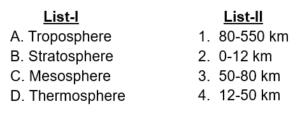
Codes:
a) A-2, B-4, C-3, D-1
b) A-2, B-4, C-1, D-3
c) A-4, B-2, C-1, D-3
d) A-4, B-2, C-3, D-1
Q3.Match the components of the primordial atmosphere (List-I) with their approximate proportions (List-II):-
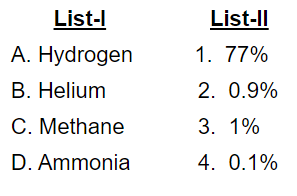
Codes:
a) A-1, B-2, C-3, D-4
b) A-1, B-2, C-4, D-3
c) A-3, B-2, C-4, D-1
d) A-2, B-3, C-4, D-1
Q4. Match the column:

Codes:
a) A-4, B-3, C-1, D-2
b) A-4, B-3, C-2, D-1
c) A-3, B-4, C-1, D-2
d) A-1, B-2, C-3, D-4
Q5. What role did the escape of lighter gases like hydrogen and helium play in shaping Earth’s early atmosphere?
a) They contributed to the formation of the ozone layer
b) They influenced the development of early life forms
c) They led to the loss of water vapour from the atmosphere
d) They facilitated the formation of volcanic eruptions
Q6. Match the components of the National Clean Air Program (List-1) with their objectives (List -II):-

Codes:
a) A-2, B-3, C-1
b) A-2, B-1, C-3
c) A-3, B-2, C-1
d) A-1, B-2, C-3
Q7. Match the following pollutants with their impact on air quality:-

Codes:
a) A-2, B-4, C-3, D-1
b) A-2, B-4, C-1, D-3
c) A-3, B-4, C-1, D-2
d) A-3, B-4, C-2, D-1
Q8. Which atmospheric layer is characterized by the presence of the ozone layer?
a) Troposphere
b) Mesosphere
c) Stratosphere
d) Thermosphere
This is all about the Geography Class-3 Atmosphere. In next class, we will discuss about the Temperature, Factors affecting temperature, Distribution of temperature etc.
| Some Important Links | |
| Geography Class-3 YouTube Short Video |
Click Here |
| Download Geography Class-3 PDF | Click Here |
| If you are satisfied with our website iaspcsprep.com, Please like and share with more people. | |
| Subscribe our YouTube Channel |
Subscribe Now |
| Join our Telegram Channel | Join Now |
| Follow our WhatsApp Channel | Follow Now |
| Join our WhatsApp Group for PDF | Join Now |
| Follow our Facebook Page | Follow Now |
| For any Query and Feedback, Contact Us at – study@iaspcsprep.com. | |

